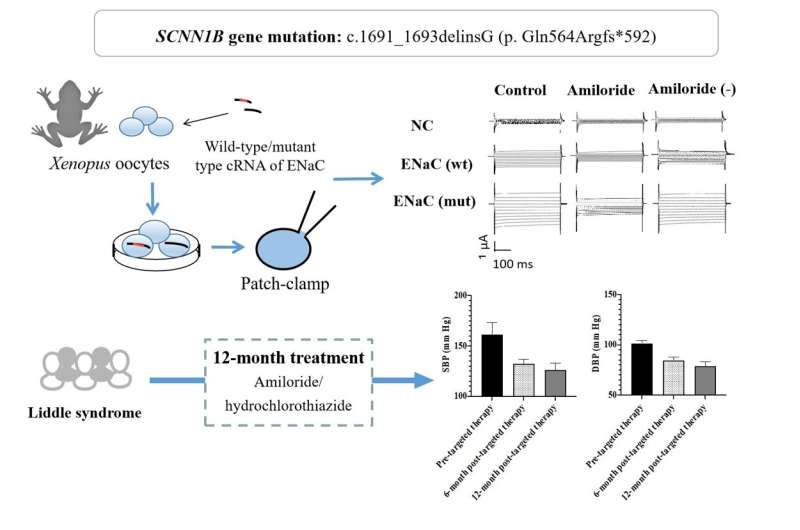This article has been reviewed according to Science X's editorial process and policies. Editors have highlighted the following attributes while ensuring the content's credibility:
fact-checked
trusted source
proofread
Identification of a novel frameshift mutation in the SCNN1B causing Liddle syndrome

Hypertension is a cardiovascular disease that seriously threatens global public health. Early and effective control of blood pressure can prevent the occurrence of target organ damage and cardiovascular complications.
Notably, although the majority of patients with hypertension are primary and polygenic, there are some patients with monogenic hypertension, in which a causative genetic mutation is responsible for developing the disease. Targeted therapy of monogenic hypertension can lead to a better prognosis, however, precise management of these patients through genetic testing remains a challenge for hypertension treatment at present.
Liddle syndrome (LS) is an autosomal dominant monogenic hypertension characterized by early-onset hypertension, hypokalemia, hypoaldosteronism, and low plasma renin.
LS is caused by the mutations in SCNN1A, SCNN1B, and SCNN1G genes encoding the α, β, and γ subunits of the renal epithelial sodium channels (ENaCs) respectively. For LS patients with SCNN1B mutations, the deletion or structural change of the PY motif at the C-terminal of βENaC prevents ENaCs from recognizing and connecting to Nedd4-2 (an E3 ubiquitin-protein ligase), resulting in increased ENaCs abundance on the cell membrane and increased sodium influx.
SCNN1B mutations are the most common in patients with LS, however, few studies have validated the pathogenicity of these mutations. Amiloride is a specific blocker of ENaCs that can effectively treat LS. However, due to insufficient use of genetic testing and imperfect mutant spectrum, some patients may be misdiagnosed or missed.
The frame-shift mutation (c.1691_1693delinsG) of SCNN1B gene was identified by whole-exome sequencing and Sanger sequencing in a family with hypertension. In this research, wild-type (ENaC (wt)) and mutant (ENaC (mut)) models were established using Xenopus oocytes, and the whole cell current was measured by patch-clamp technique.
Results showed that the amiloride-sensitive Na+ currents was increased in Xenopus oocytes expressing mutant ENaCs compared with those expressing wild-type ENaCs, suggesting that c.1691_1693delinsG of SCNN1B gene could significantly increase the sodium influx of ENaCs. This result was consistent with the molecular biological mechanism of LS. In addition, seven patients with LS in this family were followed up after 12 months treatment.
The result showed that the treatment of amiloride/hydrochlorothiazide effectively controls the blood pressure and serum potassium of these patients and no patient developed drug tolerance.
In summary, this study demonstrated that the c.1691_1693delinsG of SCNN1B gene is a new mutation site responsible for LS, which further expanded the mutant spectrum of LS and provided the possibility to improve the diagnosis rate of LS. In addition, a 12-month observational study found that the combination of amiloride and hydrochlorothiazide was safe and effective, providing new evidence for targeted medication in patients with LS.
The paper is published in the journal Science Bulletin.
More information: Yi Qu et al, Identification of a novel frameshift mutation in the SCNN1B causing Liddle syndrome, Science Bulletin (2023). DOI: 10.1016/j.scib.2023.02.006




















